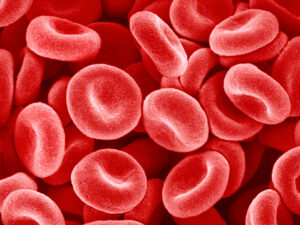During storage, red blood cells (RBCs) develop metabolic and morphological “storage lesions.” The intracellular pH is an important variable that contributes to metabolic storage lesions, as glycolysis is inhibited at pH < 7.0. Standard RBC storage solutions, however, such as citrate-phosphate-dextrose (CDP) and saline-adenine-glucose-mannitol (SAGM) have a pH of 5 to 6. Phosphate-adenine-glucose-guanosine-gluconate-mannitol (PAGGGM) is an experimental, alkaline storage solution that has shown promising results in vitro. In order to determine if PAGGGM results in improved metabolism of stored RBCs and post-transfusion recovery in vivo, 20 healthy males in the Netherlands were transfused autologous biotinylated RBCs stored for 35 days in either PAGGGM or SAGM. Simultaneously as a control, all of the volunteers also received an autologous transfusion of RBCs stored for only 2 days in SAGM labeled with a different weight of biotin. Blood samples were drawn 10 minutes, 30 minutes, 1, 2, 4, 6, and 8 hours after transfusion as well as 1, 2, 7, 30, and 90 days after transfusion. The post-transfusion recovery of RBCs stored in PAGGGM and SAGM were similar across all time points, but RBCs stored in PAGGGM had increased glycolytic activity up to one day after transfusion. The new alkaline storage solution PAGGGM is not superior to SAGM which is currently used.
Reference:

